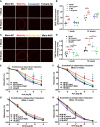Helicobacter pylori infection selectively attenuates endothelial function in male mice via exosomes-mediated ROS production
- PMID: 37274312
- PMCID: PMC10233065
- DOI: 10.3389/fcimb.2023.1142387
Helicobacter pylori infection selectively attenuates endothelial function in male mice via exosomes-mediated ROS production
Abstract
Background: Substantial sex differences exist in atherosclerosis. Excessive reactive oxygen species (ROS) formation could lead to endothelial dysfunction which is critical to atherosclerosis development and progression. Helicobacter pylori (H. pylori) infection has been shown to attenuate endothelial function via exosomes-mediated ROS formation. We have demonstrated that H. pylori infection selectively increases atherosclerosis risk in males with unknown mechanism(s). The present study was to test the hypothesis that H. pylori infection impaired endothelial function selectively in male mice through exosome-mediated ROS formation.
Methods and results: Age-matched male and female C57BL/6 mice were infected with CagA+ H. pylori to investigate sex differences in H. pylori infection-induced endothelial dysfunction. H. pylori infection attenuated acetylcholine (ACh)-induced endothelium-dependent aortic relaxation without changing nitroglycerine-induced endothelium-independent relaxation in male but not female mice, associated with increased ROS formation in aorta compared with controls, which could be reversed by N-acetylcysteine treatment. Treatment of cultured mouse brain microvascular endothelial cells with exosomes from H. pylori infected male, not female, mice significantly increased intracellular ROS production and impaired endothelial function with decreased migration, tube formation, and proliferation, which could be prevented with N-acetylcysteine treatment.
Conclusions: H. pylori infection selectively impairs endothelial function in male mice due to exosome-mediated ROS formation.
Keywords: Helicobacter pylori; atherosclerosis; endothelial dysfunction; reactive oxygen species; sex difference.
Copyright © 2023 Zhang, Xia, Wu, Liu, Zhu, Wang, Hao, Cui, Li, Chen, Martinez-Lemus, Hill, Xu and Liu.
Conflict of interest statement
The authors declare that the research was conducted in the absence of any commercial or financial relationships that could be construed as a potential conflict of interest.
Figures





Similar articles
-
CagA+ Helicobacter pylori, Not CagA- Helicobacter pylori, Infection Impairs Endothelial Function Through Exosomes-Mediated ROS Formation.Front Cardiovasc Med. 2022 Mar 31;9:881372. doi: 10.3389/fcvm.2022.881372. eCollection 2022. Front Cardiovasc Med. 2022. PMID: 35433874 Free PMC article.
-
Helicobacter pylori Infection Impairs Endothelial Function Through an Exosome-Mediated Mechanism.J Am Heart Assoc. 2020 Mar 17;9(6):e014120. doi: 10.1161/JAHA.119.014120. Epub 2020 Mar 15. J Am Heart Assoc. 2020. PMID: 32174233 Free PMC article.
-
N-Acetylcysteine Reduces ROS-Mediated Oxidative DNA Damage and PI3K/Akt Pathway Activation Induced by Helicobacter pylori Infection.Oxid Med Cell Longev. 2018 Apr 26;2018:1874985. doi: 10.1155/2018/1874985. eCollection 2018. Oxid Med Cell Longev. 2018. PMID: 29854076 Free PMC article.
-
Extracellular vesicles from helicobacter pylori-infected cells and helicobacter pylori outer membrane vesicles in atherosclerosis.Helicobacter. 2022 Apr;27(2):e12877. doi: 10.1111/hel.12877. Epub 2022 Jan 31. Helicobacter. 2022. PMID: 35099837 Review.
-
Helicobacter pylori: a ROS-inducing bacterial species in the stomach.Inflamm Res. 2010 Dec;59(12):997-1003. doi: 10.1007/s00011-010-0245-x. Epub 2010 Sep 5. Inflamm Res. 2010. PMID: 20820854 Review.
Cited by
-
Macrophage-derived exosomes in cancer: a double-edged sword with therapeutic potential.J Nanobiotechnology. 2025 Apr 26;23(1):319. doi: 10.1186/s12951-025-03321-1. J Nanobiotechnology. 2025. PMID: 40287762 Free PMC article. Review.
-
Extracellular vesicles and endothelial dysfunction in infectious diseases.J Extracell Biol. 2024 Apr 12;3(4):e148. doi: 10.1002/jex2.148. eCollection 2024 Apr. J Extracell Biol. 2024. PMID: 38938849 Free PMC article. Review.
-
Extracellular vesicles in Helicobacter pylori-mediated diseases: mechanisms and therapeutic potential.Cell Commun Signal. 2025 Feb 11;23(1):79. doi: 10.1186/s12964-025-02074-6. Cell Commun Signal. 2025. PMID: 39934861 Free PMC article. Review.
References
Publication types
MeSH terms
Substances
Grants and funding
LinkOut - more resources
Full Text Sources
Medical

